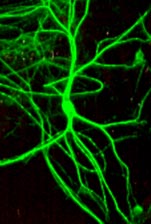Trophic Factors
Overview
Scientists have gathered direct evidence that trophic factors can salvage dying neurons in animal models of ALS. But human trials have failed so far to follow up on that success. Targeted delivery to a needy cell may allow successful therapy with trophic factors. It might take more than one trophic factor to effect a treatment for ALS.

What are Trophic Factors?
The helper molecules that allow a neuron to develop and maintain connections with its neighbors are called trophic factors. These small proteins work through their receptors on the surface of the nerve cells. When trophic factors attach to these docking sites, other reactions are put into play within, to keep a cell alive. Without trophic factors, a nerve cell may die. This is because the nervous system originates in excess, with an overabundance of cells that eventually get pruned. Just as a strong, productive fruit tree is created by judicious pruning, researchers think that the pruning of the developing nervous system produces the efficient connections that allow smooth movement and efficient cognition. Trophic factors maintain the connections that are retained as development and learning take place.
Target Tissue is Crucial
Neurons depend on their intended targets to supply the crucial trophic factors. Many different kinds of target cells are able to secrete trophic factors to nourish their innervating neurons. An example is the relationship between motor neurons and the skeletal muscles that these nerve cells command to contract. During development, about half of the motor neurons within the growing spinal cord eventually die. Yet these motor neurons don't begin to die until after their extending axons have reached the target muscle. Scientists think that the target muscle does not provide enough trophic factors to maintain the survival of all motor neurons which try to innervate it.
Researchers also know that the endings of neurons will take up and transport back to the nerve cell body the various trophic factors produced in the target, be it another neuron, or a muscle, or other end organ.
What Role do Trophic Factors Play in ALS?
In adults, trophic factors are still at work to maintain neurons, and it is possible that boosting the supply of these molecules could help sick neurons back to health. Scientists have gathered direct evidence that trophic factors can salvage dying neurons in animal models of ALS. But human trials have failed so far to follow up on that success. For instance, ciliary neurotrophic factor (CNTF) failed to demonstrate efficacy and caused harmful effects in clinical trials. The key issue with trophic factors is they have difficulty reaching the target cells in ALS. The large amount that must be given to overcome the delivery issue has produced unwanted side effects.
Challenges
Giving a trophic factor might produce too much sprouting of nerve fibers, as so many different types of neurons respond to the treatment. Some unexpected consequences of trophic factor treatment in people have included appetite suppression and weight loss, increased pain perception, and muscle aches.
Targeted delivery to a specific, needy cell may allow successful therapy with trophic factors. Gene therapy is one way that scientists are testing to selectively aid only ailing neurons. A gene that produces the trophic factor can be placed directly into the brain, by implanting cells that normally make it, or by genetically engineering them to make it. Or, the gene can be moved into neurons by a disarmed, carrier virus.
Growth factors are large molecules unable to survive intact when swallowed as a pill, because they are protein and are digested. They also are unable to cross the blood-brain barrier when administered by injection. So alternatives must be explored.
A trophic factor can be infused directly into the cerebrospinal fluid, or implanted in a depot of biodegradable, sustained-release material. Or, it can be hidden inside a "Trojan horse" molecule that is normally carried across the blood-brain barrier. Also, manipulating signals set in motion after a trophic factor docks, might be a possible strategy for ALS.
Chemists might be able to fabricate molecular mimics of trophic factors that would pass the blood-brain barrier. Or, a drug might be designed to be able to get into the nervous system and induce the formation of a trophic factor locally. It might take more than one trophic factor to effect a treatment for ALS. Many different avenues are actively examined by researchers in this field.
Recursos en español disponibles. Por favor llame al (212) 619-1400. Gracias.
42 Broadway, Suite 1724, New York, NY 10004 | (212) 619-1400
©2019 The ALS Association Greater New York Chapter. All rights reserved.
DONATE